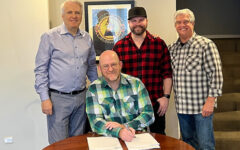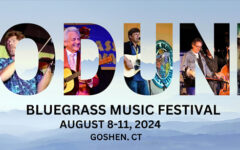
 Auld Lang Syne is a Scottish folk song, most commonly associated with Scottish bard Robert Burns, whose artistic legacy is celebrated on this date in his native country. He described it as ‘a song of olden times’ which appears to have been handed down orally, from singing parent to listening child, until Burns wrote it down, thought to have been in 1788.
Auld Lang Syne is a Scottish folk song, most commonly associated with Scottish bard Robert Burns, whose artistic legacy is celebrated on this date in his native country. He described it as ‘a song of olden times’ which appears to have been handed down orally, from singing parent to listening child, until Burns wrote it down, thought to have been in 1788.
Although the words have been handed down through subsequent years, the original tune seems to have been lost. That said, Burns did compose a song, called O Can Ye Labour Lea, Young Man, which had a very similar melody.
The earliest germ of Auld Lang Syne in lyric form is found in an anonymous poem of the 15th century, which is preserved in the Bannatyne MSS (manuscripts) of 1568, the title in this instance being Auld Kyndness Forgot.
The second song on the subject known to exist belongs to the time of Charles I and was first printed in James Watson’s Collection, published in 1711. It is a song of ten eight-line stanzas, divided into two parts, and the title here is, curiously, Old Long Syne. It has been attributed to Sir Robert Ayton of Kinaldie, in Fife, the friend of dramatist and poet Ben Jonson, but is more generally believed to be the work of Francis Sempill of Belltrees.
Just to add to the confusion, Gilmour’s Scottish Songs states that Burns wrote three of the verses, but does not specify which.
For generations the song has been sung as the clock strikes 12:00 midnight on New Year’s Eve, and to a lesser extent on Burns’ Night (January 25) and on St Andrews’ Day (November 30).
The following are the words to Auld Lang Syne as in Burns’ Selected Poems, with chorus added as in the song.
Auld Lang Syne
Should auld acquaintance be forgot,
And never brought to min’?
Should auld acquaintance be forgot,
And auld lang syne?
Chorus:
For auld lang syne, my jo,
For auld lang syne,
We’ll tak a cup o’ kindness yet
For auld lang syne.
We twa hae run about the braes,
And pou’d the gowans fine;
But we’ve wander’d monie a weary fit
Sin’ auld lang syne.
Chorus
We twa hae paidl’d I’ the burn,
Frae morning sun til dine;
But seas between us braid hae roar’d
Sin’ auld lang syne.
Chorus
And there’s a hand, my trusty fiere,
And gie’s a hand o’ thine;
And we’ll tak a right guide-willie waught,
For auld lang syne.
Chorus
And surely, ye’ll be your pint-stowp,
And surely I’ll be mine;
And we’ll tak a cup o’ kindness yet,
For auld lang syne.
The last verse here is normally the second verse in the most commonly known version.
Music was vital to Burns who apparently taught himself to play the fiddle, enabling him to pick out and record the tunes, which he did by noting down his fingering on paper. Otherwise many old folk songs would have been lost to us.
Whether this version of the song is the same as that noted by Burns, one can not be certain. By many accounts Mairi Campbell’s rendition carries the oldest known melody for Auld Lang Syne.
Some will recognize this as part of the soundtrack to the motion picture Sex and the City.
The recently-deceased Bill Keith played Auld Lang Syne, in his own inimitable style, of course. This feature is as much a tribute to him as it is a celebration of a song of long ago.
Enjoy Burns Night (tonight).
Tae the haggis!!







